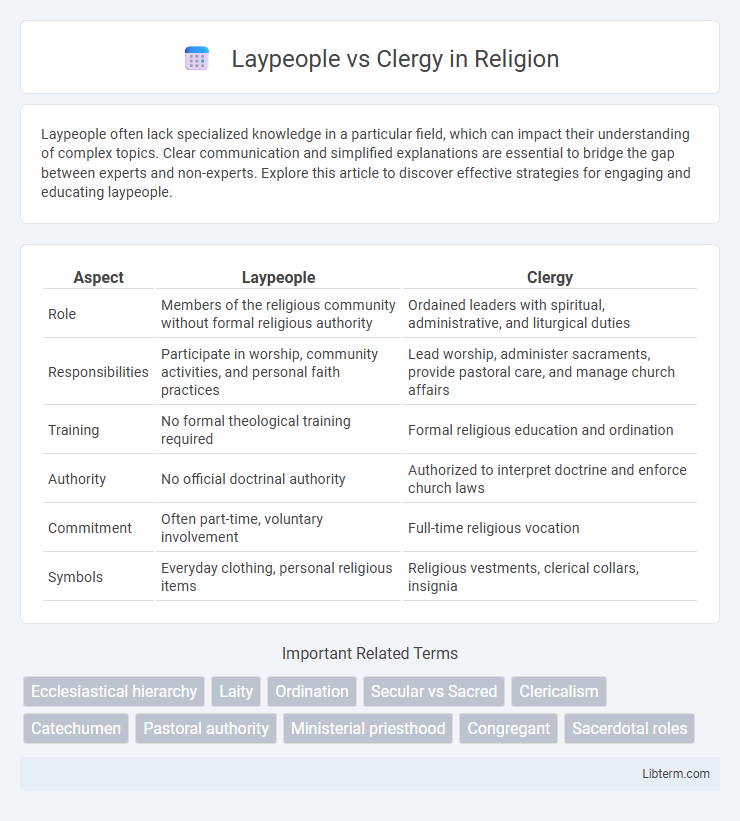Laypeople often lack specialized knowledge in a particular field, which can impact their understanding of complex topics. Clear communication and simplified explanations are essential to bridge the gap between experts and non-experts. Explore this article to discover effective strategies for engaging and educating laypeople.
Table of Comparison
| Aspect | Laypeople | Clergy |
|---|---|---|
| Role | Members of the religious community without formal religious authority | Ordained leaders with spiritual, administrative, and liturgical duties |
| Responsibilities | Participate in worship, community activities, and personal faith practices | Lead worship, administer sacraments, provide pastoral care, and manage church affairs |
| Training | No formal theological training required | Formal religious education and ordination |
| Authority | No official doctrinal authority | Authorized to interpret doctrine and enforce church laws |
| Commitment | Often part-time, voluntary involvement | Full-time religious vocation |
| Symbols | Everyday clothing, personal religious items | Religious vestments, clerical collars, insignia |
Defining Laypeople and Clergy
Laypeople are individuals who participate in religious communities without formal ordination or ecclesiastical authority, often engaging in worship and community activities without leading sacraments. Clergy refers to ordained members of a religious institution, such as priests, ministers, or rabbis, who have received formal training and authorization to perform religious rites, administer sacraments, and provide spiritual leadership. The distinction between laypeople and clergy is central to many faith traditions, emphasizing differing roles in religious practice and governance.
Historical Context of Lay-Clergy Distinctions
During the Middle Ages, the distinction between laypeople and clergy was sharply defined by the Church's hierarchical structure, with clergy holding exclusive rights to administer sacraments and interpret scripture. Laypeople, comprising the majority of the population, were generally excluded from theological education and ecclesiastical authority, reinforcing social and religious stratification. This division was pivotal in shaping medieval society's governance, law, and cultural norms, reflecting the Church's immense influence over both spiritual and secular life.
Roles and Responsibilities: Laypeople vs Clergy
Laypeople actively participate in various church activities such as volunteering, community outreach, and supporting worship services, while clergy focus on sacramental duties, pastoral care, and theological leadership. Clergy are responsible for preaching, administering sacraments like baptism and communion, and providing spiritual guidance, whereas laypeople support these functions through education, administration, and evangelization. The distinct roles highlight a collaborative relationship where clergy lead religious practices and laypeople sustain church operations and community engagement.
Spiritual Authority and Leadership
Spiritual authority in religious contexts is often divided between laypeople and clergy, with clergy traditionally holding formal leadership roles such as priests, pastors, or imams who guide worship, interpret sacred texts, and administer sacraments. Laypeople, while typically lacking official ecclesiastical authority, contribute to spiritual leadership through community involvement, lay ministry, and personal faith practices that support the religious body's mission. The dynamic interaction between clergy's institutional authority and laypeople's participatory roles shapes governance, doctrinal influence, and the distribution of spiritual responsibilities within many faith traditions.
Education and Training Requirements
Laypeople typically receive informal or minimal religious education, focusing mainly on personal faith development and community participation. Clergy undergo extensive formal education and training, including seminary studies, theological degrees, and practical pastoral experience to prepare for leadership roles. The rigorous academic and spiritual formation of clergy equips them with the necessary skills for administering sacraments, preaching, and guiding congregations.
Participation in Religious Rituals
Laypeople typically participate in religious rituals by attending services, engaging in communal prayers, and following prescribed rites without leading them, whereas clergy perform specialized roles such as conducting ceremonies, delivering sermons, and administering sacraments. The clergy's participation requires formal ordination and theological training, distinguishing their liturgical authority and responsibilities from those of lay members. This division shapes the structure of religious communities, emphasizing leadership, ritual expertise, and spiritual guidance within the clergy compared to the supportive, participatory role of laypeople.
Influence on Church Governance
Laypeople shape church governance through participation in councils, voting on key issues, and influencing parish decisions, fostering accountability and community representation. Clergy maintain hierarchical authority, guiding doctrinal interpretation and administrative functions, ensuring theological consistency and organizational structure. The balance between lay involvement and clerical leadership varies by denomination, impacting decision-making processes and church policy development.
Social Perceptions and Stereotypes
Laypeople are often perceived as less knowledgeable or spiritually inexperienced compared to clergy, who are seen as authoritative figures embodying religious wisdom and moral guidance. Stereotypes portray clergy as disciplined, celibate, and devoted to religious duties, while laypeople are viewed as ordinary believers with varied levels of commitment. Social perceptions may create a divide, attributing greater respect and influence to clergy within religious communities and broader society.
Lay Involvement in Modern Religious Communities
Lay involvement in modern religious communities has significantly increased, with laypeople actively participating in leadership roles, worship services, and community outreach programs. This shift promotes a more inclusive and collaborative environment, empowering non-ordained members to contribute to theological education and social justice initiatives. Many denominations now encourage lay ministry training, fostering spiritual growth and enhancing the overall vitality of congregations.
Bridging the Gap: Collaboration and Challenges
Collaboration between laypeople and clergy enhances community engagement by combining the practical insights of lay members with the spiritual leadership of clergy, fostering a more dynamic and inclusive church environment. Challenges such as differing interpretations of doctrine and decision-making authority often require open communication and mutual respect to bridge gaps effectively. Strategies like shared leadership roles and joint ministry initiatives promote unity while addressing potential conflicts between these two groups.
Laypeople Infographic

 libterm.com
libterm.com